Even if you prefer one type of 3D printing material for your FDM projects, understanding 3D printer filament is essential. The variety of material stored in spools amazes! From translucent to color-changing to flexible and glow-in-the-dark, there are so many new 3D printer filament types in the market that it can be a stunning idea to test the whole variety and see how you can improve or simplify your projects in 2025.
Let’s look at the most popular, best among enthusiasts, rare, and strongest 3D printer filament to help you select the types that your 3D printed figures and models can benefit from. Using multicolor, gradient, transparent, rainbow, and other filaments, you can avoid cleaning and post-processing work in many of your 3D prints.
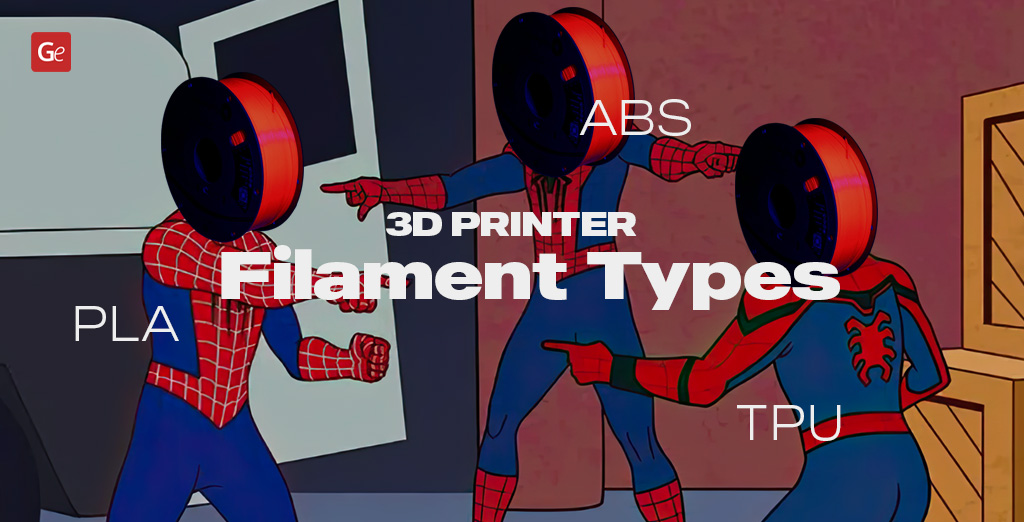
Read also: Most Popular Types of 3D Printers & How They Work.
3D Printer Filament Types
The two most popular types of 3D printers among hobbyists are FDM/FFF (fused deposition modeling/fused filament fabrication) and SLA/DLP (stereolithography apparatus/digital light processing). The first type uses 3D printer filament, while the second one needs resin.
Read also: Different Types of 3D Printer Resin for Miniatures and Big Models.
FDM/FFF machines feed different types of 3D printer filament through their extruders, and the heated nozzle runs this material from the spool onto the bed, building your model or figure layer by layer. Different types of filaments for 3D printing have varying properties, require different temperatures, and have their advantages and disadvantages, ranging from fragility to strength. Finding the best 3D printing filament for your project can save you time, money, and nerves.
ABS
Acrylonitrile Butadiene Styrene, commonly known as ABS, is one of the most popular 3D printer filaments among hobbyists. It supports high temperatures and is considered tough and durable enough to create lovely 3D prints.
Although this plastic can cause warping issues during cooling, it can withstand the test of time and serve you well once you learn how to work with it. ABS is considered a food-safe 3D printer filament. It doesn’t dissolve in water, but it can be dissolved with acetone and other organic solvents.
- Recommended nozzle temperature for ABS: 446°F to 482°F (230°C to 250°C);
- Recommended bed temperature: 95°F to 110°F (35°C to 43°C);
- Strength: 40 MPa.
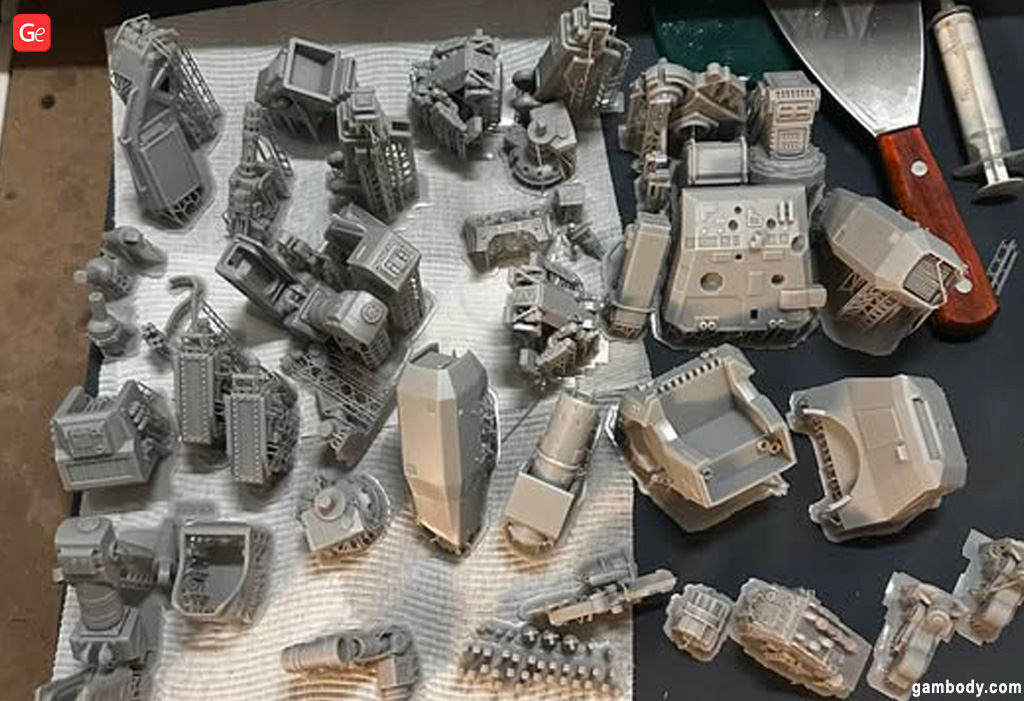
Get impressive MOOSE Mech 3D printing model STL files to assemble yours.
ABS is used in numerous goods and household items, and it is durable, strong, and can withstand stress and high temperatures. At the same time, it is difficult to print with because you have to keep your bed and nozzle heated, and work in a well-ventilated room due to the hazardous fumes this plastic releases.
PLA
Polylactic acid, also known as PLA (a thermoplastic monomer), is derived from organic materials, making it an environmentally friendly material. It’s one of the most popular types of filament for 3D printing among hobbyists, who appreciate its food-safe properties and the fact that it is unlikely to warp when creating your model or figure.
Compared to some other 3D printer filament types, PLA is more fragile and has less UV resistance. You can dissolve it using acetone, caustic soda, and other products.
- Recommended nozzle temperature for PLA: 374°F to 446°F (190°C to 230°C);
- Recommended bed temperature: 122°F to 140°F (50°C to 60°C);
- Strength: 38 MPa.
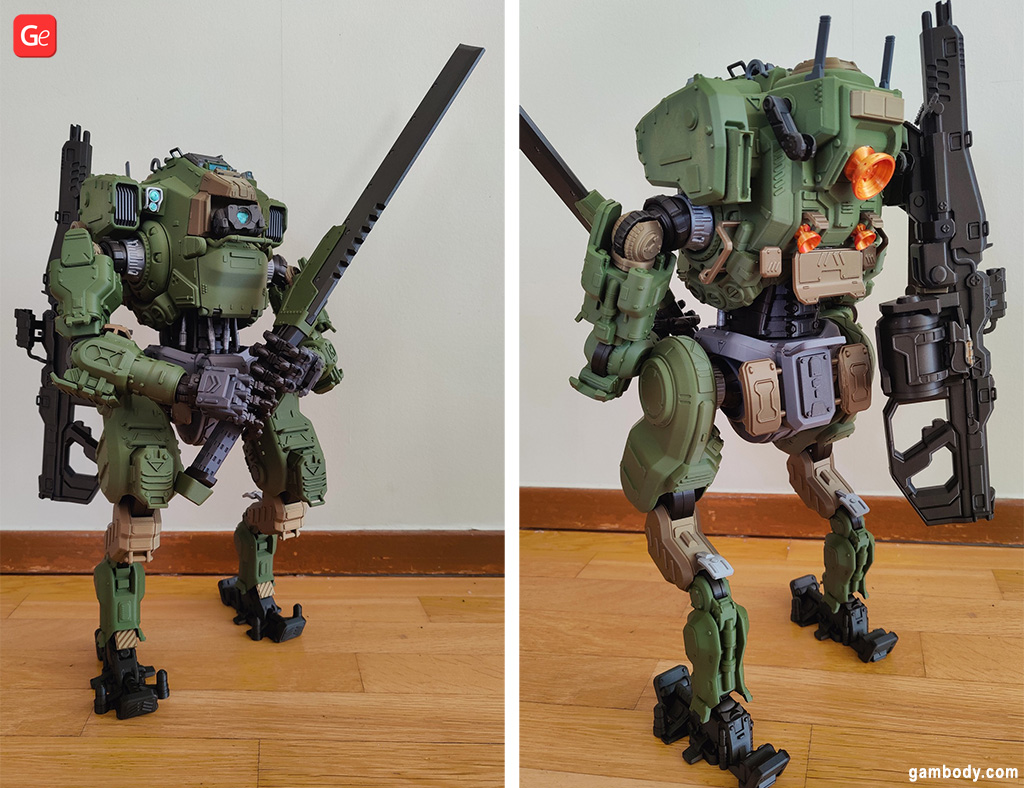

Fans of Titanfall can download the BT-7274 figure 3D model from gambody.com.
PLA is one of the easiest 3D printer filament types, as it doesn’t even require a heated bed, which still helps achieve better results. This plastic does not have an unpleasant odor during printing, and it is available in various colors, allowing you to choose the best options for your project, often eliminating the need for post-process painting.
Many manufacturers offer the most incredible options for PLA filament for 3D printer, including:
- Glow-in-the-dark PLA;
- Metal-like shiny PLA;
- Rainbow PLA;
- Dual-color, multicolor, and gradient PLA;
- Color-change PLA;
- Wood-like PLA;
- Clear (transparent, transculent) PLA.
PLA is perfect for 3D printing figures from your favorite comics, movies, TV series, and video games. It’s difficult to say what this 3D printer filament is unsuitable for. Anything that is solid and doesn’t require twisting or bending can be made with PLA. Anything you mean to display and are not planning to drop can be created with this material.
PETG
An improved version of PET, PETG, rarely called polyethylene terephthalate glycol-modified by hobbyists, is a user-friendly 3D printer filament. Being food-safe and durable, it can be the base for your 3D printed figures and models.
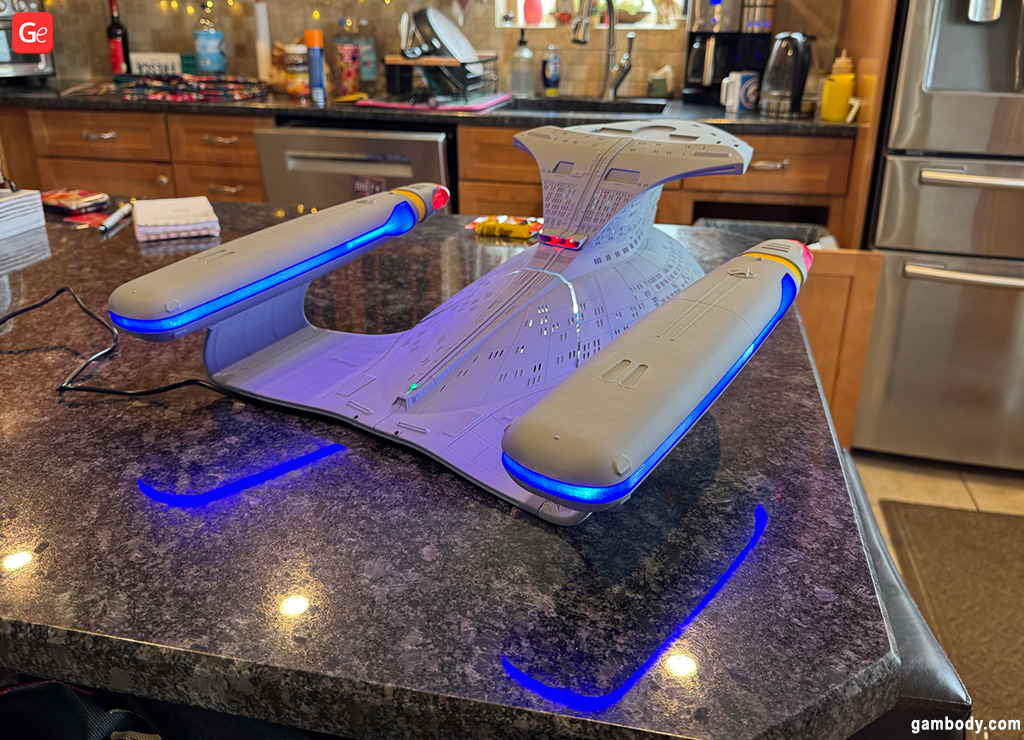

PETG has its cons. It’s not UV-resistant and causes strings as you print, but unlike some other plastics, it does not warp. You can dissolve this type of filament for 3D printer using methyl ethyl ketone.
- Recommended nozzle temperature for PETG: 446°F to 482°F (230°C to 250°C);
- Recommended bed temperature: 167°F to 194°F (75°C to 90°C);
- Strength: 53 MPa.
Flexible Filament
FLEX, or flexible copolymer, is the most popular 3D printer filament among enthusiasts who print car tires and other model parts that require flexibility. This proprietary blend of polymers is a member of the TPU family (we’ll describe it below).
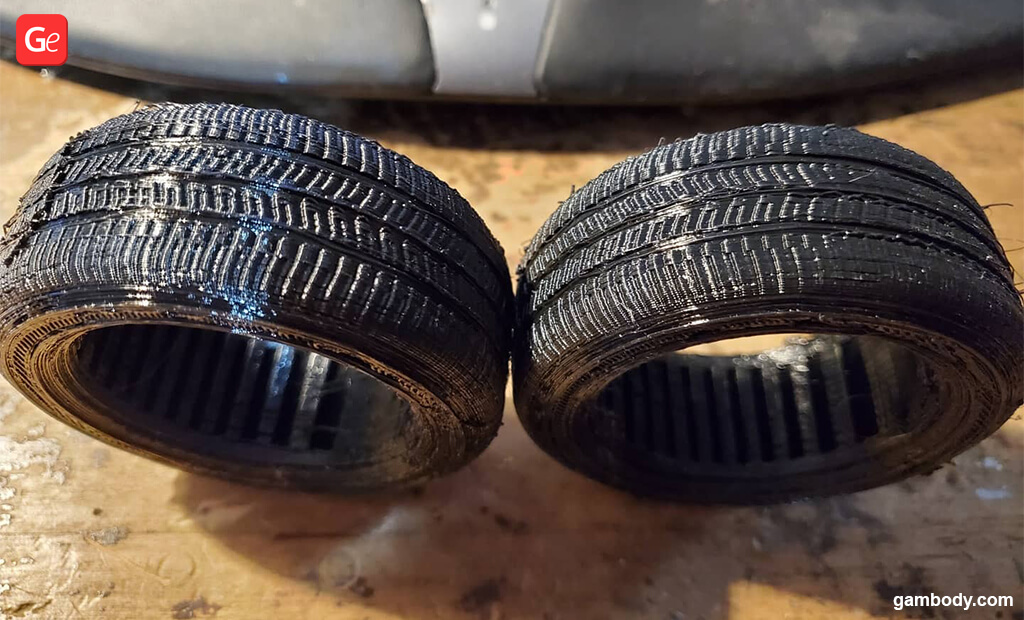

Download the DeLorean time machine STL files to print and assemble Kit 1.
FLEX is the best 3D printing filament for flexible models because it is impact-resistant and doesn’t warp. At the same it, it tends to absorb moisture from the air, so you need to dry it before printing and keep it dry as you print.
- Recommended nozzle temperature for FLEX: 410°F to 446°F (210°C to 230°C);
- Recommended bed temperature: 140°F (60°C);
- Strength: 40 MPa;
- Hardness: 93 Shore A.
Read also: How to 3D Print Flexible Filament at Home (Tips for Success).
TPU
Thermoplastic polyurethane, commonly called TPU by hobbyists, is another flexible 3D printer filament that is great for newbies and advanced users. This rubber-like material is very durable, reminding everyone of plastic. Yet, it’s less environmentally friendly than PLA.
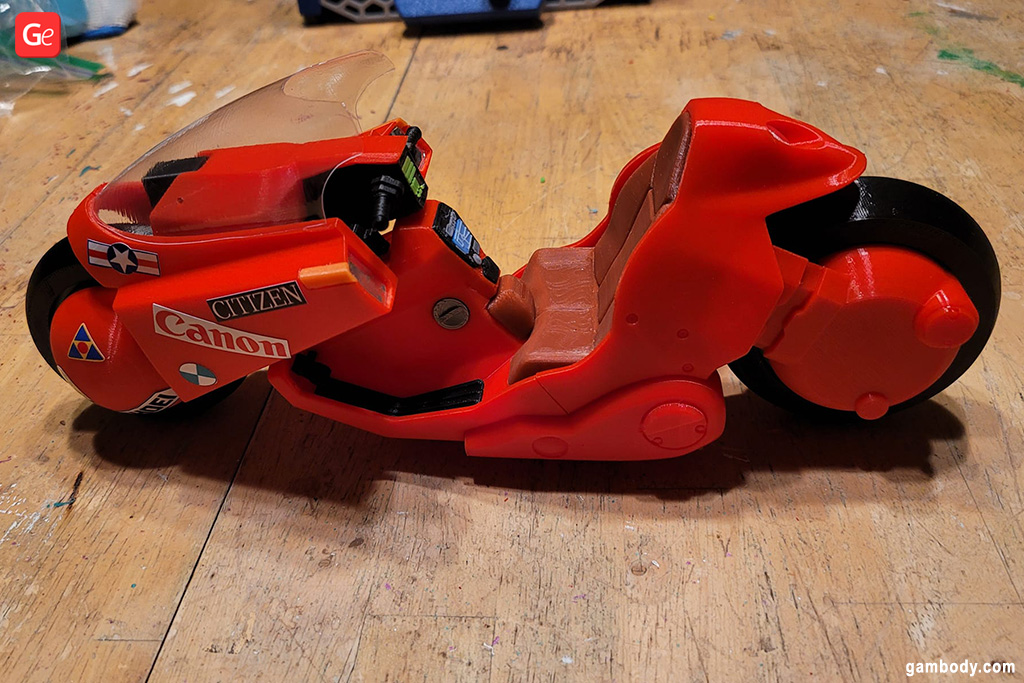

Download the Akira Bike 3D printing model from Gambody marketplace.
While TPU has numerous pros, its primary drawback is that, due to its flexibility and softness, it is very hard to 3D print with thermoplastic polyurethane. You have to work very slowly at speeds between 5 mm/s and 40 mm/s, adjusting your flow rate and retraction.
- Recommended nozzle temperature for TPU: 410°F to 464°F (210°C to 240°C);
- Recommended bed temperature: 104°F to 140°F (40°C to 60°C);
- Strength: 25 to 50 MPa;
- Hardness: 60 to 95 Shore A.
TPE
The two 3D printer filament types, TPE and TPU are often mistaken for each other. TPE is thermoplastic elastomers, a flexible, printable material with high elasticity and excellent bonding capabilities.
Thermoplastic filament doesn’t warp, but it is hard to print with.
- Recommended nozzle temperature for TPE: 464°F (240°C);
- Recommended bed temperature: 212°F (100°C);
- Strength: 32 MPa.
PA
Polyamide or nylon, also called PA, is another interesting filament for 3D printer. Its wear-resistant and durable features make it a popular plastic for engineers and 3D printing enthusiasts.
Among different nylon types of 3D printer filament, PA 6 is the most widely used grade. While the material has many advantages, its con is easy moisture absorption and printing at high temperatures, which can lead to warp issues.
- Recommended nozzle temperature for PA: 437°F to 509°F (225°C to 265°C);
- Recommended bed temperature: 158°F to 194°F (70°C to 90°C);
- Strength: 40 to 85 MPa.
Carbon Fiber Filament
Among different types of filament, you’ll see carbon fiber ones that contain special additives to make them more enhanced and dimensionally stable. While carbon fiber material doesn’t warp too much, it can cause clogging issues because of its brittleness.
- Recommended nozzle temperature for carbon fiber filament: 428°F to 464°F (220°C to 240°C);
- Recommended bed temperature: 212 °F to 230 °F (100°C to 110°C);
- Strength: 46 MPa.
PVA
Polyvinyl alcohol, better known as PVA, is one of the most popular accompanying 3D printer filament types. Because it is biodegradable and dissolves in water, hobbyists prefer to use it in conjunction with PLA as a support material.


PVA doesn’t warp easily and is user-friendly, but it costs more than other filaments, is not food-safe, and can be easily damaged by excess moisture.
- Recommended nozzle temperature for PVA: 365°F to 392°F (185°C to 200°C);
- Recommended bed temperature: 113°F to 140°F (45°C to 60°C);
- Strength: 78 MPa.
HIPS
Thermoplastic, known as high-impact polystyrene, or HIPS, has similar properties to ABS and often accompanies it as a support material. Being food-safe, durable, and a pretty strong 3D printer filament, HIPS is not as popular as other types because it releases harmful fumes while printing and requires a well-organized and ventilated work area.
HIPS is not easy to work with because it easily warps if you don’t follow the temperature requirements.
- Recommended nozzle temperature for HIPS: 446°F to 473°F (230°C to 245°C);
- Recommended bed temperature: 212°F to 239°F (100°C to 115°C);
- Strength: 32 MPa.
PC
One of the strongest 3D printer filament types, PC, is known as polycarbonate. Its mechanical properties impress hobbyists and advanced users. This thermoplastic is an advanced, durable material with high strength.
PC is hard to work with. While it is food-safe, it easily absorbs moisture, which can lead to failed 3D prints. It can also easily warp and be dissolved with chloroform and pyridine.
- Recommended nozzle temperature for PC: 500°F to 590°F (260°C to 310°C);
- Recommended bed temperature: 176°F to 248°F (80°C to 120°C);
- Strength: 72 MPa.
Strongest 3D Printer Filament
The most affordable and strongest 3D printer filament for hobbyists is PLA. However, being strong doesn’t mean being durable. Your 3D printed figures and models from PLA will be strong only if you load them up to their maximum tensile strength. Otherwise, your projects can shatter because the material itself is rigid. Hobbyists love to use PLA as the strongest filament for figures, including cartoon toys, collectible spaceship crafts, cars, boats, and busts. This material is great if you don’t stress it too much and don’t leave it in extreme temperatures.
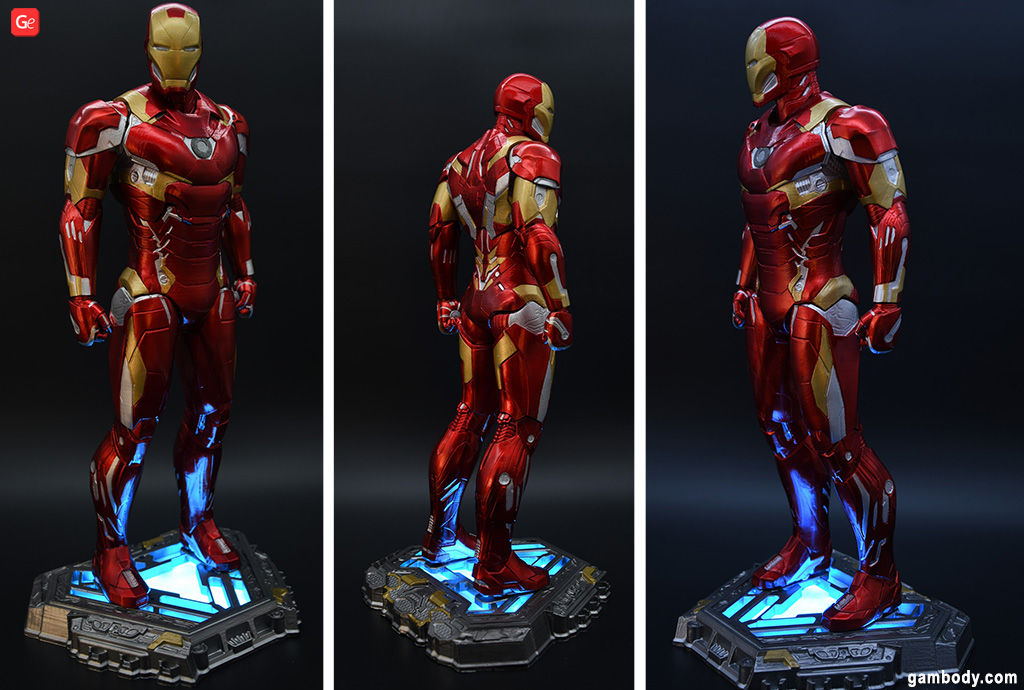

Download Iron Man Mark 46 3D printable figure STL files.
PVA, PC, ABS, and some nylon 3D printing materials are also among the strongest filament types, even stronger than PLA. Unlike PLA, PVA is significantly more expensive. PC and ABS are challenging to print with due to their ‘naughty’ nature, and nylon absorbs moisture too easily, requiring extremely high printing temperatures.
Best 3D Printing Filament
All these types of 3D printer filament are designed for various tasks, so choosing the best one depends on what you are making and for what reason. It’s best to consider your best 3D printing filament based on its simplicity and ease of use. Materials that warp easily or absorb moisture, which can lead to failed 3D prints, can be avoided.
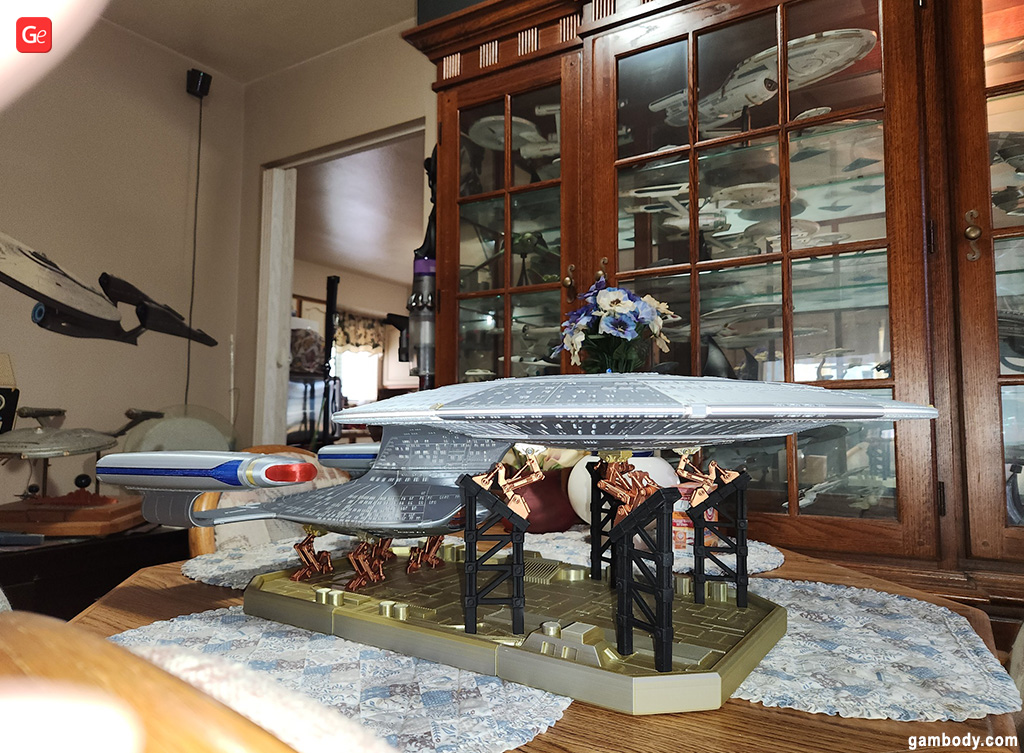

Users who enjoy creating prototypes will appreciate printing with PLA. Hobbyists who make 3D printed figures and models that need to last long and be strong might want to choose ABS and PLA, etc. When you need to print flexible, bending, compressing, and stretching parts of models and figures, choose TPU, TPE, or TPC. They may be difficult to work with, but the results can be impressive.
Sometimes, you wish to use “exotic” filaments to make your project one-of-a-kind. Sometimes, it’s best to stick to the most common 3D printer filament like PLA, ABS, and PETG, and sometimes, you should try special blends to make models with luminescence or another property.
Judged by the characteristics and pros/cons of every 3D printer filament, you can select different types of filament for various projects to ensure that each part you print is made of the best material to make it last long, be flexible, strong, etc. For example, you can combine 3D printing materials for a single project, such as a car, in which the tires need to be flexible and the body needs to be sturdy. Whatever you make, share the photos of your 3D printed figures and models with the Gambody Community on Facebook, where hobbyists from all over the world unite, showcase their collections, and advise on how to print, what settings to use, etc.
(Visited 10 times, 1 visits today)


